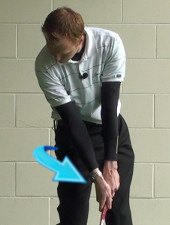
Fred Couples is the king of cool. In fact, “Boom-Boom” displays such a sleepy demeanor and tempo, he appears ready to doze off any second. Couples is so relaxed, he’s been known to let go of the club with his right hand when hitting chips and pitch shots.

This has nothing to do with attitude, however, and everything to do with technique. Hey, Freddie didn’t become one of the world’s best golfers without some serious skills.
By letting his right hand drop away as the club passes through impact, Couples prevents a jabbing motion that would send the ball scuttling past the pin. He’s literally taking his right hand out of the shot. You may have seen Tiger Woods do the same when faced with a delicate chip from greenside rough.
If you tend to chop down on short shots – especially downhillers which require a deft touch – try practicing Couples’ method. Keep your grip pressure light and let your right hand fall away at the moment of contact. If you like the results, don’t be afraid to use it on the course. Freddie sure isn’t.
Letting go with the right hand in the short game is a crucial technique that can lead to smoother, more controlled shots around the green. Here's a golf tip on how to do it effectively:
Why Letting Go with the Right Hand is Important: When chipping, pitching, or hitting delicate shots around the green, a common mistake is gripping the club too tightly with the right hand (for right-handed golfers). This tight grip can restrict the natural wrist hinge and lead to inconsistent and erratic shots. Letting go with the right hand allows for a smoother, more relaxed motion and better control over the clubface.
Golf Tip: How to Let Go with the Right Hand:
- Grip Pressure Awareness: Be conscious of your grip pressure during the short game. On a scale of 1 to 10 (10 being the tightest), aim for a grip pressure of around 3 to 4. This lighter grip will allow for better feel and touch.
- Thumb Pressure: Pay attention to the pressure of your right thumb (again, for right-handed golfers). The thumb should have a soft, light touch on the club, which encourages a natural release of the right hand through impact.
- Relax the Wrists: Allow your right wrist to naturally hinge during the backswing and follow-through. Avoid keeping the right wrist rigid and locked, as this can lead to chunked or bladed shots.
- Practice Swinging with One Hand: During practice, try hitting short shots with just your left hand (right hand for left-handed golfers). This drill can help you get a sense of how the clubhead releases through impact without excessive right-hand interference.
- Feel the Clubhead: Focus on feeling the weight of the clubhead during the swing. This sensation can help you stay connected to the club and promote a smoother release.
Q&A:
Q: Can I use this technique for full shots as well? A: While the primary focus is on the short game, maintaining a light grip pressure and allowing for some right-hand release can also benefit full shots, especially with wedges and delicate approach shots.
Q: Will this change affect my distance control? A: With practice, you'll gain better distance control and touch around the greens by letting go with the right hand. It allows for a more refined and consistent stroke.
Q: How can I overcome the fear of letting go and hitting errant shots? A: Start with shorter chips and pitches where the risk is minimal. Gradually build confidence and trust in the technique before applying it to longer shots.
Q: Should I consciously release the right hand or let it happen naturally? A: While you should be aware of the right hand's release, it should happen somewhat naturally as you develop a softer grip and more relaxed swing.
Remember, the short game is all about finesse and feel. By letting go with the right hand, you'll develop better touch around the greens and become more adept at hitting those delicate shots close to the pin. Practice this golf tip regularly to improve your short game and lower your scores.





